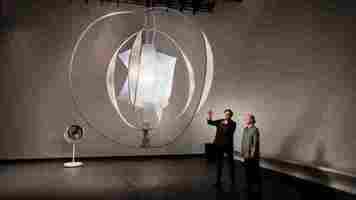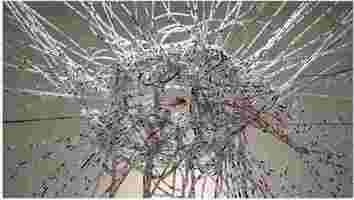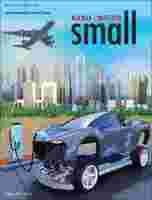Can art mobilize people to fight climate change? This artist thinks so
Neuroscientists at Columbia University observed a curious thing . When they asked a group of test subjects to concentrate on a painting of an angel wielding a sword, they found it triggered responses in the subjects’ wrists. Others have reported the sensation of dancing when observing Degas’ Ballerinas. This is due to a process called embodied cognition. When we view a piece of art, our brain mirrors actions depicted on the canvas.

Not only can art inspire physical action, it can also stimulate emotion and make the intangible feel tangible. According to eco artist Thijs Biersteker :
Sounds neat… but why does it matter? Well, EV manufacturer Polestar is betting on art’s stimulating powers to get its sustainability message across.
The company recently released a sustainability report for its new Polestar 2. While the report is an essential part of Polestar’s push towards brutal, bare naked transparency, the team behind it had to ask themselves whether it was the best way to achieve it. If no one reads sustainability reports besides the nerdiest of current EV drivers, do they make any impact at all?
That’s why they teamed up with Biersteker to create an interactive installation inspired by key data from the report. The piece titled, We Harvest Wind , is now on display at the Stedelijk Museum in Amsterdam.
TNW got an exclusive interview to find out about the backstory behind this intriguing piece and the underlying call to action.
Transforming cold hard data into climate art
“ When I was growing up, I noticed that I stopped resonating with news headlines. We read for years about deforestation in the Amazon and the dangers of plastics in our oceans, but it didn’t change anything. This is really dangerous,” Biersteker said.
He started to work with researchers from around the globe to see how he could use their rough data to create something that connects people to the numbers in a deeper way:
In the past, he’s focused on creating awareness pieces including plastics from the ocean that mirror the movements of your body and an installation showing the amount of toxins that leak out of just one cigarette butt.


When it comes to producing art based on complex climate change data, sometimes drawing out one stat or figure in a report can really help bring it to light. Just like one small change in our lifestyle can have a much bigger impact than we might realize.
Could an installation make you think twice about choosing canvas or plastic at the grocery store or tossing that cigarette butt onto the street? Biersteker hopes so.
Visualizing the switch to renewable energy
Earlier this year, Polestar released what they call an ‘ LCA (Life Cycle Assessment) report ’ getting down to the nitty gritty details of the environmental impact of their new Polestar 2, from the materials being used to the end of life emissions of the car.
One of the key parts of the report was an assessment showing how long it takes for drivers to offset production and manufacturing emissions based on the type of energy used to power their car.
“ Buying an EV isn’t enough, we have to ensure it’s charged with renewable energy,” Fredrika Klarén, Head of Sustainability at Polestar, explained. “It’s been so confusing for consumers to understand whether an EV is actually better than a petrol car because the automotive industry hasn’t put real data into the conversation.”
Klarén said this is why Polestar wants to take a new approach by being more transparent than other car brands. “We’re going to publish the LCAs for all our upcoming models. You’ll see when we fail and you’ll see when we progress. It’s really a way for us to connect with our consumers and build trust.
But, as she explained, they had to ask themselves, if there’s a report and no one reads it, will it make an impact?
That’s when they decided to contact Biersteker.
When reading the report, the data around the impact of simply switching to renewable energy sources was particularly striking for the artist. Zeroing in on this, he decided to create a massive wind turbine that could be powered by visitors.
Experimenting with new sustainable materials
Polestar has a sustainable materials team that’s tasked with researching new materials that can be used to replace non-sustainable components in future models, with the ultimate goal to produce a climate-neutral car by 2030. Klarén explained:
Biersteker’s studio teamed up with their researchers to create the installation.
Polestar is already making headway in creating a suitable material to replace plastic in its cars, so Biersteker decided to incorporate it in his installation.
While the center of the installation was built using 60 kg of used plastic PET bottles, the outer wings were created using Polestar’s square-patterned’ plastic replacement. The material is a flax-based weave structure and is currently used to create the BCOMP PowerRibs displayed in the Polestar Precept car.
End of life for an eco art piece
Just like Polestar’s production process, when Biersteker develops a new piece, his team conducts emissions calculations on each component to ensure the pieces they produce are as sustainable as possible. Each installation also comes with a materials passport, which makes it easier to deconstruct and recycle in the future.
This might seem like a weirdly practical approach, but for Biersteker, the goal of each piece is that it’ll have an ‘end of life’ — so there needs to be a plan in place for how to demolish his art after his death.
This is also why Biersteker’s installations aren’t for sale. If awareness pieces like this are sold to collectors or museums, they’ll probably end up in a basement somewhere. “This reduces their function. I’d rather have it shown somewhere to create that awareness,” said Biersteker.
Much like the installation, the Polestar team has also thought out an end of life plan for the Polestar 2 which is detailed in the LCA report.
What should you take away from this piece?
Art is subjective. Everyone will experience a piece from their own point of view. But Klarén hopes at least two key messages get across:
The only question left is, will this inspire you to act? Find out by visiting We Harvest Wind which will be displayed at the Stedelijk museum until November 3, 2021.
Boffins invent EV ‘power shell’ for increased range and performance
The idea of a multifunctional power suit may be common in superheroes like Iron Man, but what if an actual version of it existed?

A team of researchers from the University of Central Florida (UCF) and NASA has designed a special power suit that’s giving “superpowers” not to us — but to our EVs .
Made of layered carbon composite material and nanoscale graphene sheets, the suit works as a supercapacitor-battery hybrid device, able to store and provide energy.
It’s envisioned to be used as a car’s body shell, which you can see in the image below:


Just like a battery, the suit gets its power through charging, as well as from the EV’s regenerative braking system .
Thanks to the materials used, “its charge-discharge cycle life is 10 times longer than an electric car battery,” Jayan Thomas, co-author of the study, explains.
What does the suit bring to the table?
The first thing the tech claims to offer is increased range.
The composite material is lightweight — less heavy than steel and even aluminum — which reduces the vehicle’s weight and thus improves its range. (Don’t forget: the lighter the vehicle, the longer its range).
Plus, the suit can feed the stored energy to the electric motor, working as a “back-up battery” itself.
Specifically, the tech can extend its range by 25%, according to the researchers, meaning that a 381km-rated EV could get an extra 80 kilometers.
As a supercapacitor, the special shell can improve the electric car’s performance , providing it the extra power it needs to go from zero to 60mph in three seconds.
And despite the lightweight nature of the structure, the materials have significant impact and bending strength, enabling it to withstand a collision. They’re also nontoxic and nonflammable, which is crucial for passenger safety in case of an accident, Thomas says.
To showcase the tech’s application in EVs, the team fabricated a power suit for a toy car, which is able to operate using only the energy stored in its special body panel.
You can check it out in video below:
The suit is currently at a technology readiness level five, meaning it’s been tested in a relevant environment before being moved to a real environment, which constitutes level six.
To reach a commercial environment, it would need to pass the last stage, level nine, which would require further development and testing focused on commercial applications.
While it’s difficult to put a precise date on that, I still dream of a world where my EV becomes even more of a superhero.
Moving from the US to Europe changed my travel habits for the better
This article was written by Scott Shepard is VP Global Public Sector with Iomob on The Urban Mobility Daily , the content site of the Urban Mobility Company, a Paris-based company which is moving the business of mobility forward through physical and virtual events and services. Join their community of 10K+ global mobility professionals by signing up for the Urban Mobility Weekly newsletter . Read the original article here and follow them on Linkedin and Twitter .

From the day I was born, my life has been shaped by the automobile. You see, I was born and raised in Los Angeles. Regardless of the tired clichés, it is true, LA is a dominant car culture and that translates into music, art, cinema, and even cuisine.
Having spent my early years in Southern California, many of my formative memories were captured within the confines of an automobile. I can still recall the weekly trips with my parents traversing the LA freeway network from Pasadena to Culver City to visit my relatives.
I would also play amateur navigator for my father in these pre teen years, as his work in auto insurance involved driving all across the Los Angeles Region. In fact, this nascent role planted the seed for my future career, as a cartographer. I would be the one in charge of helping my father locate clients throughout the city, all with the help of the Thomas Brothers Guide (city atlas flip book).
Time moved on, and I eventually attended college on the east coast in Vermont. These years spent in the foreign land of “New England” were also dominated by the automobile. I learned the trials and tribulations of driving through ice, sleet, rain, and snow in 4+ seasons (they include “mud season” as a separate season to Spring in Vermont).
With a bachelors degree in Geography in hand, I realized this native Californian simply wasn’t cut out for the 4+ seasons, so I high-tailed it back to the West Coast. This time, I relocated to San Diego and graduated from school in Urban Planning. In San Diego is where I met my wife and started a family. However, this is where the influence of the automobile on my life really started to take shape.
At this time in my early 30s, my career started to take off, and so did my commuting. I would at this point average at least 30–45 minutes spent in my own car driving each way to work. While at the time it seemed quite manageable, it began to take a toll on my mental and physical health.
My wife and I relocated to Northern California to be closer to her family, and this is where the real fun begins. We purchased our first house in the East Bay of San Francisco, and I would now have a blended car/transit commute. This meant, I would spend 1.5–2 hours travelling each way in the mornings to Oakland and San Francisco. While I was committed to cut down on my percentage of time spent in a car, my travels actually ballooned into a “monster commute”, quite typical for Los Angeles and the San Francisco Bay Area. This meant, half of my two-hour commute was stuck in traffic, and then the second half was spent on an urban rail system (BART), taking me to the office. As you can imagine, these 4 hours per day spent commuting took an even greater toll on our lives and family. It was then that I downsized and began to seek opportunities that allowed for more telework, but with the requirement for frequent domestic travel.
Fast forward to four years ago, and our family made the subsequent decision to relocate overseas to Lisbon, as my wife is Portuguese, and she would be pursuing a PhD degree. My condition for the relocation was to continue our downsizing, by owning only one car. While this was met with skepticism, she agreed, and it has been our happy arrangement ever since.
It seems obvious why we would own only one automobile in Europe, as the availability and access to public transport and shared mobility options is ubiquitous. However, ours was also a deeply personal decision rooted in years spent in endless and unhealthy commutes.
Now that we’re in Europe, I walk everywhere, own a bicycle, and use public transport and micromobility as much as possible. While COVID has paused my international travel and over-emphasized my telework activities, this is an arrangement that is here to stay. As my early years were spent in the automobile, I plan to gain that time back with more active forms of mobility, for the environment, and my health.
Do EVs excite your electrons? Do ebikes get your wheels spinning? Do self-driving cars get you all charged up?
Then you need the weekly SHIFT newsletter in your life. Click here to sign up .